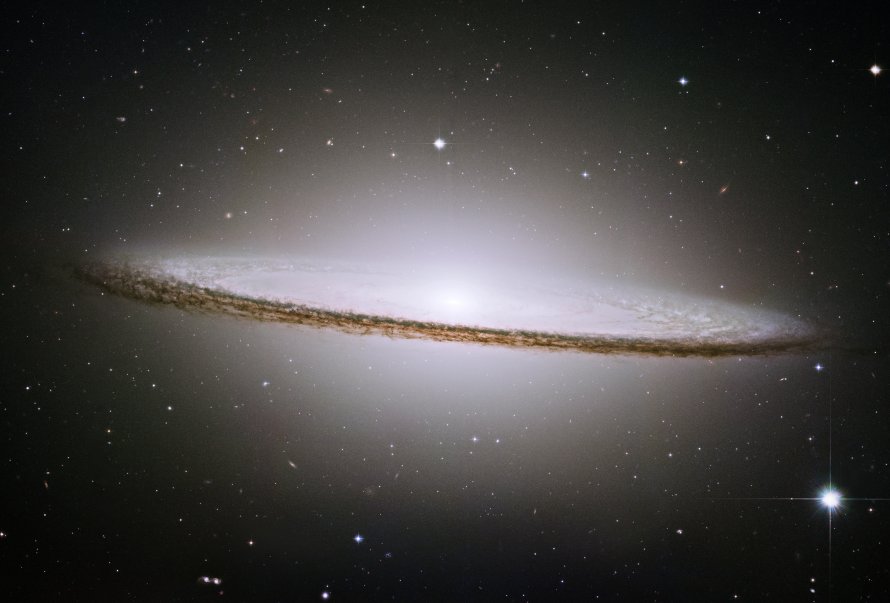M104 (NGC 4594) - Sombrero Galaxy
Messier 104 (NGC 4594), also known as the Sombrero Galaxy, is a spiral galaxy located in the constellation Virgo in the M104 Group of galaxies. M104 is 31000000 light years away from Earth.
M104 is best viewed during late spring, is magnitude 8.9, and can be viewed with binoculars. M104 is 9' x 4' in apparent size. For reference, the full moon is 30'.
Observing difficulty: Intermediate
- Name:
- Sombrero Galaxy
- Type:
- spiral galaxy
- Constellation:
- Virgo
- NGC or IC:
- NGC 4594
- Magnitude:
- 8.9
- Viewing:
- binoculars
- Size:
- 9' x 4'
- Distance (light years):
- 31000000 LY
- RA:
- 12h 39.9m
- Dec:
- -11 37'
- Season:
- late spring
- Galaxy group:
- M104 Group
- Messier Marathon #:
- 65
* The naked eye can see up to magnitude ~7-8 objects under ideal dark sky conditions.
The Sombrero Galaxy
Messier 104, famously known as the Sombrero Galaxy due to its distinctive appearance, is an unbarred spiral galaxy located in the constellation Virgo. It is one of the most famous galaxies in the night sky and is readily recognized for its unusual large central bulge and prominent dust lane. The Sombrero Galaxy was first identified by Pierre Mechain in 1781 and was added to Charles Messier?s catalogue in the 20th century.
Physical Characteristics of Messier 104
The Sombrero Galaxy spans about 50,000 light-years across, making it roughly one-third the size of our Milky Way. However, it is notable for its exceptionally large, prominent central bulge, which is much larger compared to typical spiral galaxies. This central bulge is surrounded by an extensive, tightly wound spiral structure where the galaxy's dust lane is located. These lanes are the result of interstellar dust blocking the light from the stars behind it, which creates the appearance of the brim of a sombrero hat.
The Sombrero Galaxy also hosts a supermassive black hole at its core, which is estimated to have a mass equivalent to one billion suns. Additionally, the galaxy's halo is unusually bright due to the large number of globular clusters it contains. These globular clusters, estimated to be around 2,000 in total, are about ten times more than the number found in the Milky Way.
Magnitude and Distance
Messier 104 is located about 29.3 million light-years from Earth. It has an apparent magnitude of 8.98, making it easily observable with amateur telescopes. The galaxy?s brightness, combined with its distinctive appearance, makes it a popular target for both professional astronomers and amateur stargazers alike.
Finding and Observing Messier 104
The Sombrero Galaxy is located in the constellation of Virgo, close to its border with Corvus. It can be found by following a line from Spica, the brightest star in Virgo, to Epsilon Corvi, the brightest star in Corvus. M104 is roughly halfway between these two stars.
For observers in the Northern Hemisphere, M104 is best seen during the spring and early summer. In the Southern Hemisphere, it is visible from late autumn to early winter. As the galaxy is relatively bright, it can be viewed with a small telescope or even large binoculars. The dark dust lane and the bright central bulge can be seen with a telescope of 4-inch aperture under good sky conditions. Larger telescopes will provide a more detailed view, revealing the galaxy?s halo and potentially some of its globular clusters.
The Sombrero Galaxy is a favorite among stargazers for its distinct shape and beauty, and it continues to be a subject of scientific study due to its unique characteristics and rich population of globular clusters.



